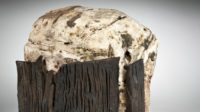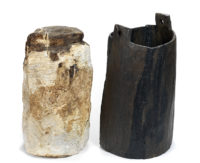 A new study has revealed that the practice of burying butter in bogs goes back even further in Irish history than we knew.
A new study has revealed that the practice of burying butter in bogs goes back even further in Irish history than we knew.
Previous analyses found that bog butters are made from animal fat, but because being buried in peat for a few thousand years can have mineralizing effects on organic matter. Some early studies concluded that it was adipocere, ie, tissue fat converted into a waxy substance in anaerobic condition, because the saturated fats in its chemical composition more closely matches those in adipocere (see this massive 77-lb stick). than in butter fat. Both theories got support in 2004 when a stable carbon isotope analysis of nine bog butters proved that six of them were the product of ruminant dairy and three from tallow, the carcass fat of ruminants.
The 2004 study looked at Scottish bog butter. The most recent study had a wider sample pool — 32 butters, and they are all Irish. The researchers also radiocarbon dated all of them to see if similar processes produced Irish and Scottish bog butters and if they could spot any trends over time. Of the 32 samples, the chemical composition of 26 of them identified them as ruminant dairy fat and another three were found to be likely from a dairy source. The remaining three samples could not be precisely classified.
 The radiocarbon dating results had a nice surprise. A sample of bog butter from Knockdrin was found to date from between 1745 and 1635 B.C.
The radiocarbon dating results had a nice surprise. A sample of bog butter from Knockdrin was found to date from between 1745 and 1635 B.C.
“We have known for a long time that bog butter was some sort of animal fat. However, compound-specific stable isotope analysis of the fatty acids in the degraded bog butters is the only way to identify the true origins of the fat – whether it was a milk fat like butter, or a carcass fat like tallow or lard.” said Professor Richard Evershed from the University of Bristol.
“Combining this analysis with radiocarbon dating, we obtain unparalleled insight into an extremely long-lived activity,” said UCD’s Dr Smyth.
“Together with two recently dated samples, this study brings to five the number of Bronze Age bog butters recorded from Ireland. Their date is extremely significant and pushes back known depositional activity by as much as 1500 years.”
Dr Smyth added: “Clearly, it is unlikely there was a single reason for the deposition of bog butter over four millennia. In certain periods they may have been votive deposits, while at other points in time it may have been more about storage and even protection of valuable resources.”
Professor Evershed notes that: “The widespread occurrence of these enigmatic butter deposits fits with our increasing knowledge of the central importance of dairying in prehistoric northern Europe.”
The study has been published in the journal Scientific Reports.
“Mum, this butter is too hard to spread!”
“Well, I’ve only just taken it out of the bog.”
I wonder also whether there was a noticeable change in flavour for the younger bog butters, a mere year or two in the bog?
The use of a spring box was common up until the advent of rural electrification on most country places, here in Ohio, that were lucky enough to have a good running spring. I ran on one made from an old bathtub a few years ago. The farm was gone, the tub was plumbed where the spring water came in the drain hole and out the old overflow hole and then on down to a stock tank. There was not much left of the lid but it was evident the contrapstion had a lid at one time. The farmstead was located in second growth timber at least a half mile off any modern road.
I grew up on a farm in rural Massachusetts – farm buildings dated back to mid-1700s. There was a spring box nearby that had been used for food storage up until the early 1900s. When I was a girl in the 1960s it was still in good condition and its purpose was clear. I remember the big heavy lid.
When I read this article about bog butters, I wondered if researchers had talked with local people, especially older people, to see if any knowledge of this practice remained, not necessarily with bog storage, but with particular uses of animal fats that might shed some light on WHAT and WHY
Cause what did the Irish eat before they had potatoes? Dairy products (butter) and oat bread.
So, Susie, the cruelty of history is that people starved in Ireland during the potato famine surrounded by forgotten butter stored in bogs? I had never thought of it that way. :ohnoes:
Um, without upsetting anyone, history knows why the Irish starved.
The ‘Fe‘ rune, describes “horned livestock” -and- “wealth or money” (cf. the terms ‘fee’, Feoh, or in Latin ‘pecunia’ for money -vs.- ‘pecus’ or vee/ Vieh). However, cheese making in northern Europe is almost 6000 years old, and milk fat was there as well.
For those that did not have a safe ‘cellar’, I wonder if anybody successfully tried ‘Peat-Peccorino’ :yes:
Also, one could e.g. dump cheese into bogs, in return for tokens that you call ‘Neolithic Stone Balls‘ (money). All this with ‘butter’ as interest and -very important- a ‘Cult’ all around it (i.e. with sacrifice, flames, music and all that).
—————
Feoh byþ frófur fira gehwylcum (‘Feoh’ shall comfort mankind on the whole).
—————
On a sidenote: Rumors have it that I was caught red-handed as a toddler, when I had just eaten a complete block of butter (allegedly on two occasions, even). Panicking they took me to the doctor, who calmed them down that I obviously had needed the butter. It might be sheer coincidence, but ever since then, I mainly eat cheese but hardly any butter at all.
—————
P.S.: Maybe, it has been done! —“A grayish cheese-like substance, partially hardened, not much like butter, and quite free from putrefaction. A version of bog butter, ‘Smen’ is still produced in North Africa – it is butter processed with thyme to start an enzyme process, then wrapped in herbs, encased in wood and stored in bogs. It is considered a gourmet food comparable to fine cheese.”